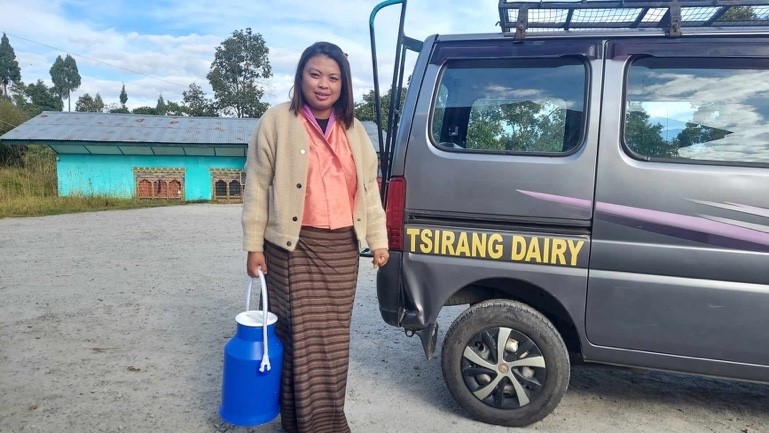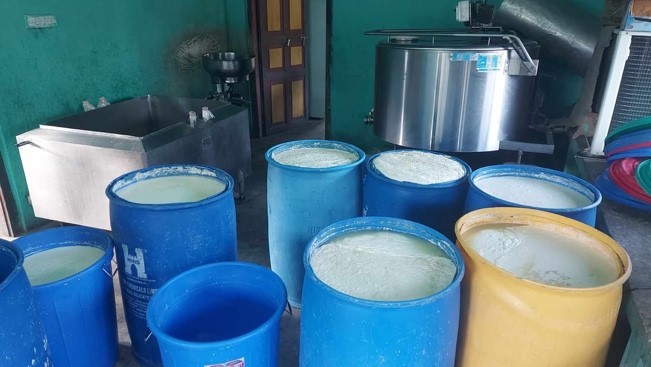An increase in crossbred population with higher yield had a resultant effect for upward drift in milk production, fostering a gradual transformation of dairy farming from subsistence farming into a more market-led operation. To handle an increased volume of milk produced, farmers are organized into dairy groups/cooperatives which provide a platform within the dairy chain management to maintain the daily flow of milk, product processing, and transferring to market outlets for sale.
However, scattered milk-producing households is a challenge to have enough memberships of Dairy Farmers’ Groups to collect reasonable quantities of milk. The limited volume of milk production and collection has slowed the growth and often made the group operations unsustainable.
Clustering of four adjoining dairy groups by Tsirang Dzongkhag (district) Livestock Sector (Rangthaling, Kihkorthang, Tsholingkor and Goseling and sometimes even Semjong Dairy group) to organize milk collection, processing, and marketing of dairy products from a central location at Damphu has proven to upscale milk collection and processing to operate at the economy of scale. This model is found to be suitable and appropriate to be replicated in other potential clusters in the dzongkhag and other dzongkhags in the country.

The combined/ clustered dairy groups with over 650 members collect over 2000 liters (morning milk) daily from group members. Milk is collected from the nearest road point of the member’s residential area by office bearers (Chairman/Secretary of respective Dairy Groups) and transport themselves or engage a transporter (on a payment basis) to collect from the road point and reach the milk to centrally located Milk Processing Unit (MPU) at Damphu. In the absence of chilling facilities at strategic locations, evening milk often gets spoiled and is not collected. It is estimated around 1000 l/day of evening milk can be collected totaling 3000 l/day (morning + evening) milk even in lean season (December 2023). Milk production in summer is reported to exceed 4000 l/day from the same cluster.
But the processing facilities at Damphu established in 2011 when milk collection was just about 100 liters, have inadequate space to handle above 2000 liters of milk in a day. Moreover, with the current skills and facilities/equipment available, the milk processor (Mr. Mon Bahadur Dahal) feels that he is not in a position to process and market more than 2000 l/day.
At the central milk processing unit, the processor, selected through competitive bidding by the Dzongkhag Livestock Sector, Tsirang (also a member of one of the dairy groups) handles the milk aggregated from four dairy groups. Cream from the milk received is separated using the cream separator. Skimmed milk is fermented in a plastic drum (in place of limited availability of stainless steel or aluminum vats) to process into cottage cheese. The butter is processed from the cream separated. Yogurt and paneer are also processed based on demand and the dairy products are sold in the name of “Tsirang Dairy”.


The Tsirang Dairy has identified retailers in Thimphu City (Motithang and Babesa), Puna-Tsangchu colonies, and Wangdue town to sell dairy products. Dairy products are packed and sent through public transport to reach the pre-determined marketplaces. The retailer also picks up the products in bulk from the sale outlet of MPU engaging their transporters. Local consumers buy directly from the sales outlet of the MPU.
Processor pays to respective dairy groups and farmers every month and group members are satisfied with timely payment and fair price paid. Currently, members receive Ngultrum (Nu) 45 per liter of milk (1USD = Nu 84.2), if they hand carry or arrange the transportation themselves to reach milk to MPU. However, if common transport is availed by a member, Nu. 3 to Nu. 4 per liter are deducted for payment to the transporter (Nu. 3/litre within a 5km radius and Nu. 4 /liter 5-12 km radius).
Each member contributes Nu. 150/month/member plus Nu. 1 for every liter of milk sold to MPU to the Group Saving fund which members can avail of as a loan in case of need at a low-interest rate.
As per the milk processor, the monthly turnover or amount dairy farmers receive is over Nu. 2,500,000 (Nu 2.5 Million) per month which is substantial. This excludes Nu. 150,000 paid as salary to 12 employees of the MPU (including the Manager himself). The salary of employees ranges from Nu. 8,500 – 18,000 per month.
From a dairy value chain development perspective, strengthening Dairy Groups and Cooperatives and upgrading Milk Processing facilities based on needs serve as milk/milk product congregating platforms (ILO, 2020). Hence, in the absence of a mechanism for the Cooperative Union and Federation, the cluster approach is found to be suitable for smallholder, dispersed milk production catchments of Bhutan. Therefore, the National Dairy Development Centre (NDDC) in close consultation/collaboration with the Department of Livestock and respective Dzongkhag Livestock Sector; shall endeavor to re-organize and cluster dairy groups/cooperatives; expand infrastructure and facilities (where possible), provide technologies and impart skills to upscale dairy chain operations. This can be a viable strategy for robust and sustainable operation of the dairy business; bringing about overall efficiency of the dairy supply/market chain management.
Contributed by: Dr. N.B. Tamang, Specialist, and Mr. Aita K. Bhujel, DCLPO, National Dairy Development Centre, Yusipang (on behalf of DLS Tsirang)
![]()

